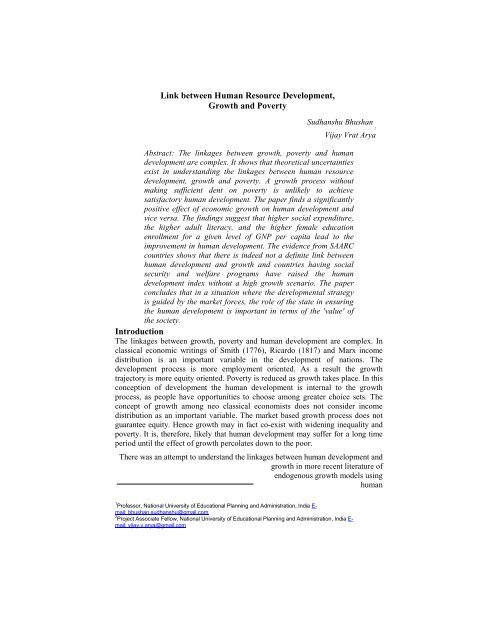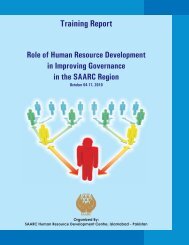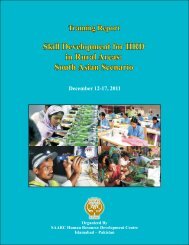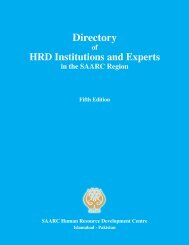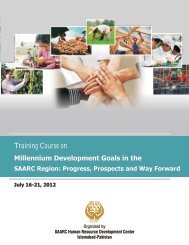Here - SAARC Human Resource Development Centre
Here - SAARC Human Resource Development Centre
Here - SAARC Human Resource Development Centre
- No tags were found...
You also want an ePaper? Increase the reach of your titles
YUMPU automatically turns print PDFs into web optimized ePapers that Google loves.
Link between <strong>Human</strong> <strong>Resource</strong> <strong>Development</strong>,Growth and PovertySudhanshu Bhushan2Vijay Vrat AryaAbstract: The linkages between growth, poverty and humandevelopment are complex. It shows that theoretical uncertaintiesexist in understanding the linkages between human resourcedevelopment, growth and poverty. A growth process withoutmaking sufficient dent on poverty is unlikely to achievesatisfactory human development. The paper finds a significantlypositive effect of economic growth on human development andvice versa. The findings suggest that higher social expenditure,the higher adult literacy, and the higher female educationenrollment for a given level of GNP per capita lead to theimprovement in human development. The evidence from <strong>SAARC</strong>countries shows that there is indeed not a definite link betweenhuman development and growth and countries having socialsecurity and welfare programs have raised the humandevelopment index without a high growth scenario. The paperconcludes that in a situation where the developmental strategyis guided by the market forces, the role of the state in ensuringthe human development is important in terms of the 'value' ofthe society.IntroductionThe linkages between growth, poverty and human development are complex. Inclassical economic writings of Smith (1776), Ricardo (1817) and Marx incomedistribution is an important variable in the development of nations. Thedevelopment process is more employment oriented. As a result the growthtrajectory is more equity oriented. Poverty is reduced as growth takes place. In thisconception of development the human development is internal to the growthprocess, as people have opportunities to choose among greater choice sets. Theconcept of growth among neo classical economists does not consider incomedistribution as an important variable. The market based growth process does notguarantee equity. Hence growth may in fact co-exist with widening inequality andpoverty. It is, therefore, likely that human development may suffer for a long timeperiod until the effect of growth percolates down to the poor.There was an attempt to understand the linkages between human development andgrowth in more recent literature ofendogenous growth models usinghuman1 Professor, National University of Educational Planning and Administration, India E-mail: bhushan.sudhanshu@gmail.com2 Project Associate Fellow, National University of Educational Planning and Administration, India E-mail: vijay.v.arya@gmail.com
Link between <strong>Human</strong> <strong>Resource</strong> <strong>Development</strong>, Growth and Povertycapital. Barro and Lee (1993) in a study of 129 countries concluded that educationlevels have a strong explanatory capacity in so far as they highlight the directpositive effects of education on growth rates. However, Benhabib and Spiegel(1994) showed that between 1965 and 1985, the growth rate of the human capitaldid not significantly explain the growth rate of the product per capita. (See MagaliJaoul-Grammare, 2008) It shows that theoretical uncertainties exist inunderstanding the linkages between growth and human development. A growthprocess without making sufficient dent on poverty is unlikely to achievesatisfactory human development. There is also a theoretical uncertainty on thecausation of growth and human development. While on the one hand the humancapital may or may not affect economic development, it has been argued thatprincipal causality stems from economy to education and not vice versa, therebynegating the principal role of human capital in economic development. (Dieboltand Monteils, 2000)Against this theoretical backdrop the paper reviews the research findings on thechains between growth and human development in both directions. It also reviewsthe empirical findings in the context of South Asia and in particular in the context ofIndian states. The empirical findings are then used to arrive at importantconclusions.Growth vs. Poverty and <strong>Human</strong> <strong>Development</strong>There is a large number of literature on the impact of growth and poverty. Thetrickle down approach to growth asserts that the effects of sustained growth willtrickle down to benefit the poor through employment opportunities and povertyratio is bound to decline. K L Datta (2008) notes that “the high growth in 2005-06was accompanied by an impressive growth of 5.9 per cent in the agriculture sector,on the back of an average growth rate of 5 per cent per year in the previous twoyears. The ability of such high growth rates in accelerating the rate of povertyreduction should not be lost sight of. However, the concept of human developmentis much more than mere poverty eradication. Poverty reduction is a necessarycondition but not sufficient to achieve human development.Mahbubul Haq, one of the architects of UNDP, spells out the concept in thefollowing manner: “The basic purpose of development is to enlarge people'schoices. In principle, these choices can be infinite and can change over time.People often value achievements that do not show up at all, or not immediately, inincome or growth figures: greater access to knowledge, better nutrition and healthservices, more secure livelihoods, security against crime and physical violence,satisfying leisure hours, political and cultural freedoms and a sense of participationin community activities. The objective of development is to create an enablingenvironment for people to enjoy long, healthy and creative lives (MHHDC,2004)”.Another view point is that there is no significant relationship between the level ofgrowth and decline in poverty. The market driven growth process may in factaccentuate economic inequality and therefore the human development may in factsuffer. Some of the Scandinavian countries stand higher in human development2
Link between <strong>Human</strong> <strong>Resource</strong> <strong>Development</strong>, Growth and Povertythan the USA and UK, though their economic growth is not higher than the later. Sois the case with Sri Lanka in South Asia and Kerala within India. The presentmarket driven economic growth does not facilitate “good and safe workingconditions, freedom to choose jobs and livelihoods, freedom of movement andspeech, liberation from oppression, violence and exploitation, security frompersecution and arbitrary arrest, a satisfying family life, the assertion of culturaland religious values, adequate leisure time and satisfying forms of its use, a sense ofpurpose in life and work, the opportunity to join and actively participate in theactivities of civil society and a sense of belonging to a community (Streeten1999).”Therefore, eradication of poverty and greater equity in income distribution alongwith human resource development is an important policy issue and must remain inthe forefront in all developing countries including SouthAsia.Research FindingsRains et. al (2000) note that there are two distinct causal chains between economicgrowth and human development. One runs from economic growth to humandevelopment, as the resources from national income are allocated to activitiescontributing to human development; the other runs from human development toeconomic development, indicating how, in addition to being an end in itself, humandevelopment helps increase national income.The connection between national income to human development is likely to bestronger:a. the lower the proportion of the population below the poverty line; for a givenlevel of GNP per capita, this means the more equally income is distributed;b. the more income households allocate to human development at a givenincome level; this may be related both to the level of female education and tofemale control over income within the household;c. the higher the proportion of GNP devoted to priority social expenditure by thegovernment;d. the more effective the contribution of social capital, including communityorganizations and other NGOs ande. the more efficient the human development improvement function (HDIF).On the other hand, the link between human development to growth is likely to bestronger:a. the higher the investment rate;b. the more equal the distribution of income andc. the more appropriate the economic policy setting.In summary, the two chains, taken as a whole, showed a significantly positiveeffect of economic growth on human development and a significantly positive3
Link between <strong>Human</strong> <strong>Resource</strong> <strong>Development</strong>, Growth and Povertyeffect of human development on economic growth. With respect to specific links ineach of the chains, findings broadly confirm the tested hypotheses, except forincome distribution in the first chain from national income to human development.The findings suggest that higher social expenditure, the higher adult literacy, and thehigher female education enrollment for a given level of GNP per capita lead to theimprovement in human development. It is surprising to note that a more equaldistribution of income did not improve human development performance.It is moreover important to note that the relationship between human developmentand economic growth was stronger the higher the investment rate and the moreequally distributed the income.The research result has an important message. Authors note that an economy may beon a mutually reinforcing upward spiral, with high levels of human developmentleading to high growth and high growth in turn further promoting humandevelopment. Conversely, weak human development may result in low growth andconsequently poor progress toward human development improvement. Thestrength of the links in the two chains influences the extent of mutual reinforcementbetween human development and economic growth, in either directionAnalysis of Empirical Results: <strong>SAARC</strong> and IndiaPer Cap ita In come, Poverty and <strong>Human</strong> development in <strong>SAARC</strong> CountriesTable below presents the scenario of per capita income, poverty, income inequalityand human development index.Table-1: Income, Poverty and <strong>Human</strong> <strong>Development</strong> Indicators in <strong>SAARC</strong>CountriesCountryPer capitaIncome, 2003(US$)Poverty %(2001) $1 aday definition,latest<strong>Human</strong>developmentIndex, 2003Gini coefficientofIncomeDistributionBangladesh 400 41.3 .520 33.4Bhutan 630 36.3 .536India 540 34.3 .602 36.8Maldives 2350 1.0 .745Nepal 240 24.1 .526 47.2Pakistan 520 17.0 .527 30.6Sri Lanka 930 5.6 .751 40.2Source: Economic and Social Commission for Asia and the Pacific (2008)Economic and Social Survey of Asia and the Pacific 2008, 'Sustaining Growth andSharing Prosperity', United Nations, New York and MHHDC (2006) <strong>Human</strong>development in SouthAsia 2005, Oxford, Karachi4
Link between <strong>Human</strong> <strong>Resource</strong> <strong>Development</strong>, Growth and PovertyRelationship between per capita income and poverty: If we examine therelationship between per capita income and poverty we observe that Maldives andSri Lanka are the two top countries in terms of per capita income and also the leastpoor states among South Asian countries. Nepal has the lowest per capita income,yet in terms of poverty ratio it is better placed than India and Bangladesh. This is soin spite of high income inequality in Nepal. It may be noted that the relationshipbetween per capita income and poverty in terms of polynomial of degree 3 showsthat higher per capita income may be associated with falling and rising povertyratio. A linear approximation of course gives a very weak relationship between percapita income and poverty, as is evident from the regression equation given inChart-1.Chart-1Relationship between per capita income and human development noted that high percapita income is not associated with high human development index.While Sri Lanka, Maldives and Nepal have performed better than might have beenexpected, given their levels of per capita GDP, in India, Pakistan and Bangladesh,social progress has lagged behind economic growth. (Bhalla, 2007) It may be notedthat quite apart from the growth momentum in any country the progress in humandevelopment is the result of the initiative of the state in the free and efficientdelivery of social services. Sri Lanka runs a unique system of free health andeducation system. This is the reason behind impressive performance of Sri Lanka inthe area of human development. Chart-2 shows that only a large proportionatechange in per capita income makes an impact on HD index.5
Link between <strong>Human</strong> <strong>Resource</strong> <strong>Development</strong>, Growth and PovertyPer Capita Income, Poverty and <strong>Human</strong> <strong>Development</strong> among Provinces inIndiaThe table below presents the indicators relating to per capita gross state domesticproduct, literacy rate, human development index, poverty ratio and infant mortalityrate.There is a negative correlation between per capita income and poverty in Indianstates, the value of correlation was modest at -0.609. It may be noted, however, thatMaharashtra and Gujarat rank high in per capita GSDP, yet poverty ranking showstheir position at 8 and 12 respectively. It shows that highest per capita GSDP statesmay have higher incidence of poverty as well. Highest poverty state such as Orissa,Bihar, Madhya Pradesh and Assam are also associated with lowest per capitaGSDP states. Kerala and Himachal Pradesh have lowest poverty incidence, yetthey may not have highest per capita GSDP. Thus from the provincial analysis ofdifferent states in India, it is observed that some of the higher per capita incomestates are not necessarily associated with lower poverty incidence, although some ofthe lowest per capita income states are generally associated with highest incidenceof poverty.The regression equation given in Chart-3 also shows that there is a weak link fromper capita income to poverty ratio. There is high correlation (0.8 8696) between percapita income of the state and human development index. It proves the point thatstates with higher per capita income are at higher stage of economic developmentand they are in a position to devote greater resources for human resourcedevelopment leading the state in HD index. What is also important to note is thatstates with lowest per capita income are at lower stage of economic developmentand they are not in a position to devote greater resources for human resourcedevelopment. As a result such states show lower human development index. Anexception in this regard is state like Kerala which top in HR development index, yetdoes not stand high in per capita GSDP.6
Link between <strong>Human</strong> <strong>Resource</strong> <strong>Development</strong>, Growth and PovertyTable-2: Rank of Different Provinces in India on Growth, Povertyand <strong>Human</strong> <strong>Development</strong> IndicatorsPer CapitaGSDP at 1993-94 prices(AnnualAverage for200 1-02 to2003-04)LiteracyRate (as% ofpopulation) 2001<strong>Human</strong>development Index(value)2001PovertyEstimation HCR1999-00InfantMortalityRate 2001(numberperthousand)Maharashtra 1 2 4 8 15Punjab 2 6 2 17 12Gujarat 3 7 6 12 9Haryana 4 9 5 15 6Tamil Nadu 5 4 3 10 13Karnataka 6 10 7 9 11Himachal Pradesh 7 3 16 9Kerala 8 1 1 14 18Andhra Pradesh 9 15 10 11 8West Bengal 10 8 8 7 13Arunachal Pradesh 11 19 5 17Uttaranchal 12 5Rajasthan 13 16 9 13 4Chattisgarh 14 11Jammu & Kashmir 15 18 18 16Jharkhand 16 20Madhya Pradesh 17 12 12 3 2Assam 18 13 13 4 5Orrissa 19 14 11 1 1Uttar Pradesh 20 17 14 6 3Bihar 21 21 15 2 7The correlation between poverty and human development is -0.77. States withhighest poverty level show lowest human development and States with lowestpoverty level show highest human development.It may also be observed that literacy rate is highly correlated with per capita GSDPthan the infant mortality rate.7
Link between <strong>Human</strong> <strong>Resource</strong> <strong>Development</strong>, Growth and PovertyReferencesBarro, R.J. and Lee, J.W. (1993), International Comparisons of Educational Attainment, Journal ofMonetary Economics, 32(3), pp. 363-3 94.Benhabib, J. and Spiegel, M.M. (1994), The Role of <strong>Human</strong> Capital in Economic <strong>Development</strong> Evidencefrom Aggregate Cross-Countries Data, Journal of Monetary Economics, 34(2), pp. 143-173.Bhalla S, (2007), Employment Generation and Poverty Reduction in the <strong>SAARC</strong> Region, The Indian Journalof Labour Economics, Vol. 50, No. 2, April June 2007, pp. 23 1-244Gustav Ranis, Frances Stewart, Alejandro Ramirez (2000), Economic Growth and <strong>Human</strong> <strong>Development</strong>,World <strong>Development</strong> Vol. 28, No. 2, pp. 197-219, 2000K L Datta (2008), An Estimate of Poverty Reduction between 2004-05 and 2005-06, Economic and PoliticalWeekly (EPW), Nov. 22, 2008Magali Jaoul-Grammare (2008), <strong>Human</strong> Capital, Economic Growth and <strong>Development</strong>: New Evidence,Journal of Educational Planning and Administration Vol. XXI, No. 1, January, pp.27-43, NewDelhi.MHHDC (The Mahbub ul Haq <strong>Human</strong> development <strong>Centre</strong>) (2004), <strong>Human</strong> development in South Asia2003: The Employment Challenge, Oxford University Press, KarachiMHHDC (The Mahbub ul Haq <strong>Human</strong> development <strong>Centre</strong>) (2006), <strong>Human</strong> development in SouthAsia2005, Oxford University Press, KarachiRicardo, D (1817), The Principles of Political Economy and Taxation, Rod Hay's Archive for the History ofEconomic Thought, McMaster University, CanadaSmith Adam (1776), An Enquiry into the Nature and Causes of Wealth of Nations, Elibron Classics, LondonStreeten Paul. (1999), Ten Years of <strong>Human</strong> <strong>Development</strong>, <strong>Human</strong> development Report 1999. Delhi: OxfordUniversity Press.9


